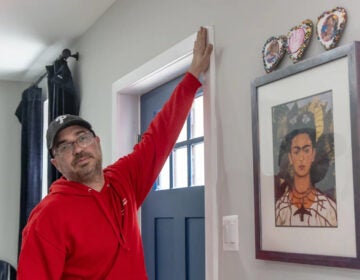A tax credit for home insulation, air conditioners and heat pumps ends soon. Here’s what to know
The Energy Efficient Home Improvement Credit saved households in Pa., Del. and N.J. more than $200 million in a recent tax year.
Listen 0:54
Heat pumps can work for both heating and cooling. You can think of a heat pump as an air conditioner that can also work backward. (Julia Simon/NPR)
This story is part of the WHYY News Climate Desk, bringing you news and solutions for our changing region.
From the Poconos to the Jersey Shore to the mouth of the Delaware Bay, what do you want to know about climate change? What would you like us to cover? Get in touch.
Time is running out to take advantage of tax credits that lower the cost of home improvements to help your household use less energy.
The federal Energy Efficient Home Improvement Credit partially reimburses households for investments such as new exterior windows and doors, efficient heaters and insulation. The credit was extended and expanded by the 2022 Inflation Reduction Act under then-President Joe Biden, then cut short by the “One Big Beautiful Bill Act” signed by President Donald Trump this summer.
Households have until Dec. 31 to make home improvements that can qualify for the credits.
“You should act on this right now,” said Jeaneen Zappa, executive director of the Keystone Energy Efficiency Alliance, a trade association representing businesses that do energy efficiency work in Pennsylvania. “This is a wonderful opportunity in the face of rising rates.”
Here’s what you need to know.
What does the tax credit cover?
The nonrefundable tax credit can reduce a household’s tax burden by up to $3,200.
Eligible services and purchases include home energy audits, insulation, air sealing, energy-efficient windows, exterior doors, new central air conditioners, energy-efficient heaters and heat pumps. Households can claim 30% of these expenses, with limits on certain items — such as $600 for a heater or air conditioner, $1,200 for insulation and $2,000 for a heat pump.
“All of these things matter,” Zappa said. “Usually, the building shell, the building envelope, is the best place to start to really make significant improvement in reducing your energy use and therefore cost and [raising] your comfort inside that home.”
The energy efficiency tax credits saved households in Pennsylvania, Delaware and New Jersey roughly $205 million in tax year 2023, according to IRS data.
Is there still time to make home improvements before the end of the year?
Zappa said none of the home improvements covered by the tax credit are “impossible” to accomplish before the end of the year.
“I think it depends on if you can get a contractor,” she said.
Don Naughton, owner of Pennsylvania-based Energy Saving Construction, said there’s still time for homeowners to get energy audits and weatherization done through his company before the end of the year. He said audits generally take a day or two, while air sealing and insulation can take up to a week.
As of mid-November, his company was booked until early December, he said.
“They call me soon, we’ll get it all in,” Naughton said.
To qualify, home improvements must be installed by the end of the day on Dec. 31, Zappa said.
Expert recommends energy audit and weatherization
If you want to take advantage of the tax credits before they expire, Simi Hoque, a professor of architectural engineering at Drexel University who studies energy conservation, recommends hiring a professional to audit your home’s energy use. The tax credit offers up to $150 toward the cost of a home energy audit done by a certified auditor.
Energy auditors find the places your home is losing heat in the winter or gaining heat in the summer. They use giant fans to suck air out of a home, pulling outside air in through cracks. They identify leaky areas using tools like infrared cameras.
Next, Hoque recommends weatherizing your home by sealing up any cracks identified in the energy audit. Weatherization can consist of installing gaskets around exterior doors, sealing cracks around window frames or insulating an attic. These measures can pay for themselves in energy savings within a few years, Hoque said.
“For the most part, when people do weatherize their house, it pays itself back,” Hoque said. “Even if they didn’t have the tax credit.”
Hoque only recommends buying a new heater if your current heater is inefficient and at the end of its life. If you need to replace it now anyway, the tax credit is a good way to lower the cost.
Hoque says a heat pump is a climate-friendly, but pricey, option.

Get daily updates from WHYY News!
WHYY is your source for fact-based, in-depth journalism and information. As a nonprofit organization, we rely on financial support from readers like you. Please give today.






